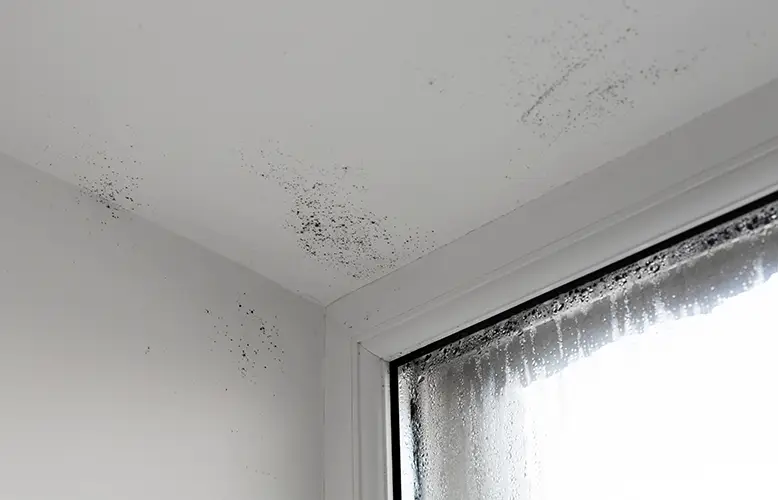Record-breaking amounts of rain have seen cases of mould explode in Canada – with many homes across the country suffering. In fact, according to new data from Homestars.com, the reliable way to hire pros, more than a quarter (26 per cent) of Canadians are reporting more mould in their homes than before.
Mould commonly affects homes across Canada, but the cold and damp weather this year so far has exacerbated the issue. Whether you have a new or old property, many of us will have to battle this problem. It is generally caused by poor ventilation, and once mould is established, it can be difficult to rid yourself of it. This is problematic as it’s not just unsightly and off-putting to potential purchasers should you be selling your home – it can also produce allergens, irritants, mould spores and other toxins that are harmful to health.
But help is at hand with a new German technique called “stossluften”. Literally translated as “shock ventilation”, the technique involves opening all your windows, several times a day, for a short period of time – whatever the weather.
The recommendation is that the windows are left open for between 5-10 minutes a time in winter, up to 15 minutes in spring and autumn, and 30 minutes a time in summer. The technique is meant to not only improve ventilation and air quality, keeping mould at bay, but also improving our health and general wellbeing.
Combining Stossluften with “Querlüften” can have even better effects. Querluften involves opening windows and doors on opposite sides of your home, creating cross ventilation. Allegedly, this can not only prevent condensation, but increase the air quality and therefore health of those living in the house.
An expert from MyHammer, Homestars’ sister company based in Germany, says Stossluften is widely used across the country.
“Airing your house regularly not only helps prevent condensation, and therefore mould, but is also reported to bring many health benefits. Millions of households in Germany use this method – it’s free, beneficial to your home and health – so why not give it a try?”
Colleen McGrory, from Homestars.com, said that a recent survey from the brand highlighted the severity of the mould issue.
“The fact that more than a quarter of Canadian homes are reporting higher levels of mould proves what an issue it is. But actually, there are often many simple ways to help ease the issue.
“Our experts explain that ventilation really is key to preventing and treating most cases of mould. Opening windows is a simple, free, and effective way to provide your home with the ventilation that it needs. However, in these winter months, your heating bill won’t thank you!
“Stossluften and Querluften are probably effective ways to treat the problem, but if your mould issue is caused by more than just condensation caused by bad ventilation, you might need a pro to come in and solve the problem.
“And even if it is a condensation problem, leaving your windows open in freezing or wet weather might not be palatable to many. In case it’s not for you, we’ve put together some simple tips to help you deal with mould in your home – but if it’s more than condensation that’s the issue, get the pros in.”
How to deal with mould – the Canadian way!
Check your whole house
It may be that mould is growing in a number of different places in your home. Ensure you check the whole house, including any areas with high humidity, a lack of air flow, or areas that are likely to have any water damage. Ceilings where the roofline is, and around the bottom of walls on ground floors, are good places to start. If you don’t treat all areas, you won’t get rid of it.
Identify the problem
Identify what’s causing the problem. Mould can be caused by a number of factors including lack of ventilation, a leak, condensation, structural issues such as thermal bridging, blocked gutters, a breach in a waterproofing measure, or poor temperature control. Treating it without understanding the source is a waste of time, effort and money. If you aren’t sure where the problem stems from, it’s a good idea to consult a pro.
If it’s condensation that’s causing the problems, try these tips:
Ventilation
If condensation is the cause of your mould problem, better ventilation to the affected area will mean it is unlikely to return. There are a number of methods to improve the ventilation in your home via heat/energy recovery ventilators (HRV/ERV), extractor fans and airing the house regularly. Simply opening the windows while cooking or showering can make a massive difference. Dehumidifiers can also be very helpful as a short term aid.
Keep it constant
Pros advise that the temperature of a room should be as constant as possible to avoid mould growth. Fluctuating temperatures can actually cause the problem to be exacerbated. Try and keep your room temperature to between 16 and 20 degrees celsius at all times.
Remove the mould
To do this, first ensure the affected area is dry. Then use a mould killer or spray to remove the mould. Ensure you have the correct protective equipment including gloves and ideally a face mask and ventilate the room when removing the mould.
Mould resistant paint
Once the mould has been removed, you could use a mould resistant paint to treat the affected area. This will add a layer of protection to help ensure it doesn’t return.
